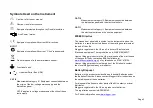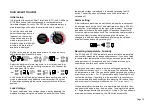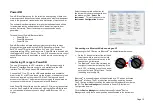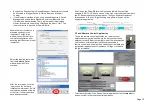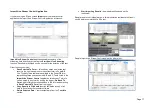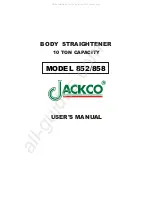
Page 2
G
SAFETY WARNINGS
Safety warnings must be observed during use:
•
The circuit under test
must
be switched off, de-energised, isolated
and checked to be safe before insulation test connections are made.
Make sure the circuit is not reenergised whilst the instrument is
connected.
•
Only 15 kV rated Megger test leads with plug inserts of 75 mm
must
only be used on the S1-1568. Lead integrity can be verified by
momentarily shorting clips together at the lowest test voltage range.
•
Circuit terminals
must not
be touched during an insulation test or
when the test LED is flashing to indicate a hazardous condition on
the measurement circuit, before suitable grounding of the unit under
test is in place in line with safe working practices.
•
The functional earth terminal on S1-1568
must
be connected to
provide a resistance path to ground, or a uni-potential bonding point.
•
After completing a test, capacitive circuits
must
be completely
discharged before disconnecting the test leads. Capacitive charges
can be lethal.
•
Tested items
must
be firmly shorted out with a shorting link, after
discharge, until required for use. This is to guard against any stored
dielectric absorption charge subsequently being released thereby
raising the voltage to potentially dangerous levels.
•
The voltage indicator and automatic discharge features
must
be
regarded as additional safety features and not a substitute for
normal safe working practice.
•
It is rare, but in certain circumstances, breakdown of the circuit
under test may cause the instrument to terminate the test in an
uncontrolled manner, possibly causing a loss of display while the
circuit remains energised. In this event, the unit must be turned off
and the circuit discharged manually.
•
Test leads, including crocodile clips,
must
be in good order, clean
and with no broken or cracked insulation.
•
The instrument
must
not
be used if any part of it is damaged.
•
Insulation testing in wet conditions might be hazardous. It is
recommended that this instrument is not used in these
circumstances. If this is unavoidable, the user
must
take all
necessary precautions.
•
This instrument is not intrinsically safe and
must
not
be used in
hazardous atmospheres.
•
If this equipment is used in a manner not specified by the manufacturer,
the protection provided by the equipment may be impaired.
•
A test can be started at any time via remote control. Measurement
connections must be handled only with the remote control indicator
beacon removed from its socket.
•
In the event of the instrument failing in remote control mode the test
must be stopped manually by pressing the TEST button.
•
If performing a two-wire test without guard using the S1-1068, insert the
blue safety plug.
•
Switch the instrument OFF and
disconnect
any AC source,
measurement leads, and all other equipment before opening the case
to change the battery. The instrument
must not
be operated with the
case open. DANGER! Hazardous voltages are exposed with an AC
source connected and the case open.
BATTERY WARNINGS
•
Do not disassemble or modify the battery. The battery contains safety
and protection devices which, if damaged, may cause the battery to
generate heat, rupture or ignite.
•
Never heat the battery in a fire or otherwise.
•
Do not pierce or damage the battery in any way
•
Do not subject the battery to strong impacts/shocks.
•
Do not expose the battery to water, salt water or allow the battery to get
wet.
•
Never short circuit, reverse polarity or disassemble the battery pack.
•
In the event of a battery cell leaking, do not allow the liquid to come into
contact with the skin or eyes. If contact has been made, wash the
affected area with copious amounts water and seek medical advice.
•
Keep cells and batteries out of reach of children
•
Seek medical advice if a cell or battery has been swallowed.
•
Do not leave a battery on prolonged charge when not in use.
•
Retain the original product literature for future reference.
NB: THE INSTRUMENT MUST ONLY BE OPERATED BY
SUITABLY TRAINED AND COMPETENT PERSONS
Users of this equipment and/or their employers are reminded that National
Health and Safety Legislation requires them to carry out valid risk
assessments of all electrical work so as to identify potential sources of
electrical danger and risk of electrical injury such as inadvertent short
circuits.



